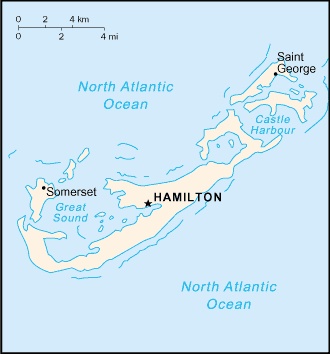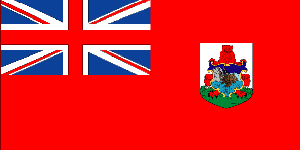
|
Bermuda
Background:
Shipwrecked English colonists headed for Virginia first settled Bermuda in
1609. Tourism to the island to escape North American winters first developed in
Victorian times. Tourism continues to be important to the island's economy,
although international business has overtaken it in recent years. Bermuda has
developed into a highly successful offshore financial center. A referendum on
independence was soundly defeated in 1995.
Location:
North America, group of islands in the North Atlantic Ocean, east of
North Carolina (US)
Area: Total: 53.3 sq km water: 0 sq km land: 53.3 sq km
Area - comparative: About one-third the size of Washington, DC.
Coastline: 103 km.
Climate and Terrain:
Climate: Subtropical; mild, humid; gales, strong winds common in winter.
Terrain: Low hills separated by fertile depressions.
Elevation extremes: Lowest point: Atlantic Ocean 0 m highest point: Town Hill
76 m
Natural resources: Limestone, pleasant climate fostering tourism
Geography - note: Consists of about 138 coral islands and islets with ample
rainfall, but no rivers or freshwater lakes.
People:
Population: 63,960.
Ethnic groups: Black 58%, white 36%, other 6%.
Religions: Non-Anglican Protestant 39%, Anglican 27%, Roman Catholic 15%, other
19%.
Languages: English (official), Portuguese.
Government:
Government type: Parliamentary British overseas territory with internal
self-government .
Capital: Hamilton.
Economy overview:
Bermuda enjoys one of the highest per capita incomes in the world, with its
economy primarily based on providing financial services for international
business and luxury facilities for tourists. The effects of 11 September 2001
have had both positive and negative ramifications for Bermuda. On the positive
side, a number of new reinsurance companies have located on the island,
contributing to the expansion of an already robust international business
sector. On the negative side, Bermuda's already weakening tourism industry -
which derives over 80% of its visitors from the US - has been further hit as
American tourists have chosen not to travel. Most capital equipment and food
must be imported, with the US serving as the primary source of goods, followed
by the UK. Bermuda's industrial sector is small, although construction
continues to be important. Agriculture is limited, only 6% of the land being
arable.
GDP - composition by sector: agriculture: 1% industry: 10% services: 89%.
Statistics:
Telephones - main lines in use: 52,000.
Telephones - mobile cellular: 7,980.
Radio broadcast stations: AM 5, FM 3.
Radios: 82,000.
Television broadcast stations: 3.
Televisions: 66,000.
Internet users: 25,000.
Railways: 0 km.
Highways: Total: 450 km.
Airports: 1.
Return to Visiting Locations
|

